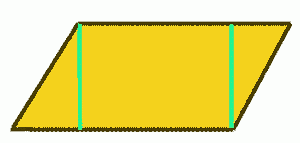
A butterfly has bilateral symmetry. Thanks to Wikimedia Commons
What is bilateral symmetry?
A shape has bilateral symmetry when it is the same on both sides of a line drawn down the middle.
Are humans symmetrical?

Venus of Lespugue, ca. 25000 BC, now in the Musee du Quai Branly, Paris
You are (mostly) bilaterally symmetrical. Suppose I drew a line down through your nose perpendicular to the ground. You’d have one eye, one arm, and one leg on each side of the line. So you’d be symmetrical. But you wouldn’t be entirely the same on both sides of the line. You only have one heart, on the left side. And you only have one liver and one appendix, on the right side.
This butterfly has bilateral symmetry too. It has one wing and one antenna on each side of the red line.

T’ang Dynasty landscape painting and poem
Because symmetry makes it clear that both sides of you are healthy and undamaged, many animals, including humans, tend to find partners more attractive when they are the same on both sides. That’s why people usually part their hair in the middle, and wear symmetrical clothing. But sometimes we like to mess with that a little bit, as a sort of tease, or to show we’re not boring. We might part our hair on the side, or wear an asymmetrical skirt.

How to figure out the area of an isosceles triangle.
Chinese painters, for example, created asymmetrical but carefully balanced paintings, so they would look interesting.
Geometry and bilateral symmetry
Some geometric shapes have bilateral symmetry, while others don’t. For example, a square has bilateral symmetry, and so does a circle. So does a rectangle. An isosceles triangle also has bilateral symmetry.

This is a rhombus, divided so you can figure out the area.
But most parallelograms do not have bilateral symmetry. A rhombus does not have bilateral symmetry vertically, but it does if you draw a diagonal line connecting two opposite corners. (Thanks to Jeffrey Paules for pointing this out!)
Three-dimensional solids can have bilateral symmetry, too. A sphere and a cube both have bilateral symmetry.
Learn by doing: painting bilateral symmetry
Perpendicular
Rectangles
Squares
Circles
Triangles
More about Geometry
Bibliography and further reading about geometry:




